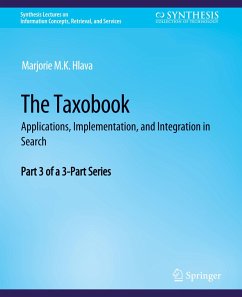This book is the third of a three-part series on taxonomies, and covers putting your taxonomy into use in as many ways as possible to maximize retrieval for your users. Chapter 1 suggests several items to research and consider before you start your implementation and integration process. It explores the different pieces of software that you will need for your system and what features to look for in each. Chapter 2 launches with a discussion of how taxonomy terms can be used within a workflow, connecting two-or more-taxonomies, and intelligent coordination of platforms and taxonomies. Microsoft SharePoint is a widely used and popular program, and I consider their use of taxonomies in this chapter. Following that is a discussion of taxonomies and semantic integration and then the relationship between indexing and the hierarchy of a taxonomy. Chapter 3 ("How is a Taxonomy Connected to Search?") provides discussions and examples of putting taxonomies into use in practical applications. Itdiscusses displaying content based on search, how taxonomy is connected to search, using a taxonomy to guide a searcher, tools for search, including search engines, crawlers and spiders, and search software, the parts of a search-capable system, and then how to assemble that search-capable system. This chapter also examines how to measure quality in search, the different kinds of search, and theories on search from several famous theoreticians-two from the 18th and 19th centuries, and two contemporary. Following that is a section on inverted files, parsing, discovery, and clustering. While you probably don't need a comprehensive understanding of these concepts to build a solid, workable system, enough information is provided for the reader to see how they fit into the overall scheme. This chapter concludes with a look at faceted search and some possibilities for search interfaces. Chapter 4, "Implementing a Taxonomy in a Database or on a Website," starts where many content systems really should-with the authors, or at least the people who create the content. This chapter discusses matching up various groups of related data to form connections, data visualization and text analytics, and mobile and e-commerce applications for taxonomies. Finally, Chapter 5 presents some educated guesses about the future of knowledge organization. Table of Contents: List of Figures / Preface / Acknowledgments / On Your Mark, Get Ready .... WAIT! Things to Know Before You Start the Implementation Step / Taxonomy and Thesaurus Implementation / How is a Taxonomy Connected to Search? / Implementing a Taxonomy in a Database or on a Website / What Lies Ahead for Knowledge Organization? / Glossary / End Notes / Author Biography
Bitte wählen Sie Ihr Anliegen aus.
Rechnungen
Retourenschein anfordern
Bestellstatus
Storno








